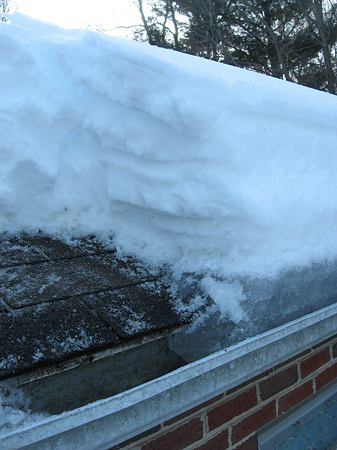Preventing Costly Home Damage from Ice Damming – Home Maintenance Tips
An ice dam is a ridge of ice that forms at the eave or valley of a roof and prevents proper drainage. Ice damming is most often caused by insufficient attic insulation and/or attic ventilation. An attic that is too warm causes roof snow to melt and slide down to the eaves. At the eaves, where the roof surface is cooler, the melting snow is likely to refreeze and cause a dam. Subsequent melting causes water to pool behind this dam, potentially leading to serious water damage. As a design build contractor serving the Virginia, Maryland and DC area, we like to remind our clients and others this time of year about the dangers of leaks linked to ice damming. A little preventative maintenance now can help all homeowners avoid the need for an unplanned home renovation.
Costly damage may occur if water seeps between the shingle layers, wetting the roof deck and possibly leaking into the home below. Visible signs of damage may include dislodged roof shingles, water-stained ceilings, peeling paint, damaged plaster, etc. As other damage may not be as obvious, such as wet attic insulation, water within the wall frames or, in the longer run, mold, any instance of ice damming should be thoroughly investigated to avoid structural and health-related issues.
To prevent ice damming, the goal is to keep the attic very close to the outdoor temperature. This is achieved through proper insulation and ventilation. The insulation will minimize excessive heat from escaping into the attic and through the roof. And, proper ventilation will quickly remove any warm air that might build up to help maintain a more uniform temperature. Consider the following helpful tips as you prepare for the winter ahead.
Attic Insulation
- Inspect your insulation for gaps, cracks or areas that have settled, been compressed, gotten wet or have otherwise been compromised.
- Replace uninsulated ceiling (can) lights with those marked IC (the letters indicate the light is safe for direct insulation contact). Then insulate around and over the lights.
- Doors leading to unheated spaces should be addressed and trimmed as if they were outside doors, complete with saddles and weather stripping.
- If your home has heating ducts that run through the attic, inspect them for leaks or improper insulation.
- Ensure that bathroom and kitchen exhaust ducts are vented to the outside. Otherwise warm and/or moist air can blow into the attic leading to warm spots and possibly reducing the effectiveness of the rest of the attic’s insulation.
Attic Ventilation
- Clear existing gable or ridge vents of insulation, dust, vines, leaves or other debris.
- Soffit vents, which draw cool into the attic through the eaves, should also be cleared of debris.
- The recommended minimum ventilation is one square foot for every 150 square feet of attic floor area.
- Ensure that there is at least one and one-half inch of space between the insulation and the roof inside the attic at the eaves to create a clear air path for improved circulation.
Finally, it is essential that you make sure gutters and downspouts are free of debris so melting water flows down and away from the house. Together, these tips will help to minimize your home’s risk of ice damming.
OTHER POSTS
